Lovers, brothers or just intense non-verbal communication? Camels awaiting riders in the ruins of Palmyra. The once great Aramaic city, centre of trading on the silk road in Syria and key stop on the road to Baghdad.
Camel Love – Palmyra, Syria
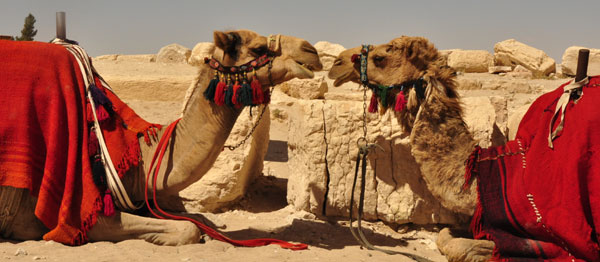

Lovers, brothers or just intense non-verbal communication? Camels awaiting riders in the ruins of Palmyra. The once great Aramaic city, centre of trading on the silk road in Syria and key stop on the road to Baghdad.
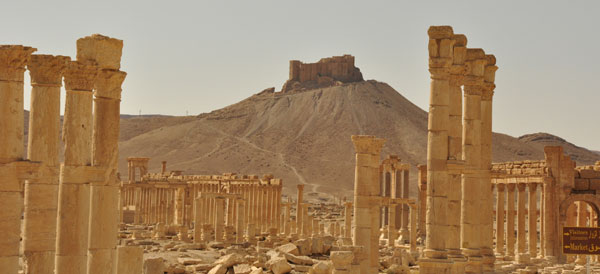
An old Arabian fort looks down on the ancient ruined city of Palymra, one of the Middle East’s greatest ancient sites and sole attraction in the ‘no man’s’ land of the Syrian desert and border with Iraq.

The ‘Monastery’ in Petra, located at the top of a mountain, it is one of innumerable buildings, tombs and even amphitheatres all carved out of the rocks & valleys in the secret city….
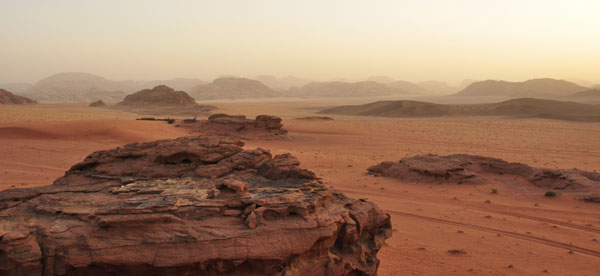
Inspiring desert horizons and striking rock formations from our bedouin camp in Wadi Rum. The playground of ‘Lawrence of Arabia’ and numerous legends from Arabian Nights…..
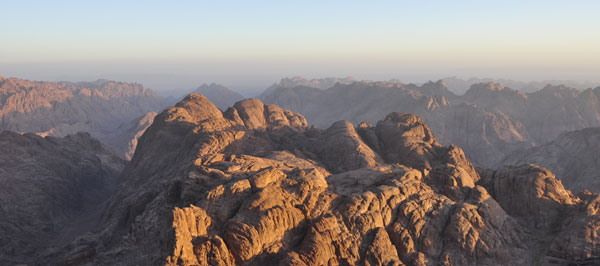
The eerie rocky landscape around Mt Sinai, makes for fantastic sunrise viewing despite the myriad of package tour groups; exotic pockets of Christians, Muslims and Jews on pilgrimages from all ends of the spectrum. Still nice to know they all have some things in common.
![In the footsteps of the Pharaohs Egypt at least initially, whether you like it or not, is all about the pharaohs and ancient Egypt. It is one of those things you […]](http://meltingplots.com/wp-content/uploads/2010/08/eye.jpg)
Egypt at least initially, whether you like it or not, is all about the pharaohs and ancient Egypt. It is one of those things you just have to do at some point and we had happily resigned ourselves to such a tourist pilgrimage. This felt like a remarkably different kind of departure from any of our prior travel escapades. While we had had glimpses of the mainstream tourist beat in Africa and India at key places, we still felt we were stitching them together in our own rather unique, independent way. Egypt though is literally plagued by tour groups from every corner of the planet and invariably we were on the same path, tainted by the same “rich short term tourist’ brush from the locals and forced to simply grin and bear it in the heat. This post then probably won’t inspire much, its one of those ‘this is what we did’ things and I get the impression that everyone else does more or less the same. But describe it I will, for it is nevertheless an amazing experience & most worthy despite the popularity.
Stage 1 – The Cairo Museum
First stop on the trail was the Cairo museum. A huge building in the middle of downtown Cairo, the place is an overwhelming treasure trove of antiquities. There is so much there it seems that long ago things stopped being categorized, organized or signposted. A new museum is being built next to the pyramids to house all this at some point which I hope will help, but for now, the only way to experience it is to simply immerse yourself floor by floor in the wonders and soak it all up. Packed to the rafters with ancient statues, sarcophagi, mummies and millions of other excavated wonders, you quickly drown in the download. The showstopper though rather obviously is the treasures from the Tutankhamen tomb. We saved it for last and after 4 or 5 hours perusing the sarcophagi, busts and other external trappings from the tombs, seeing a sample of what these may all once have contained leaves you in awe. The gold masks, jewellery and other Tutankhamen treasures are astounding in their colour, quality and detail, while the overwhelming catalogue of ‘other stuff’ found inside simply boggles with the scale of the find. We left totally worn out, but inspired and full of pharaonic dreams, excitedly anticipating the thrill of exploring the actual sites themselves.
Stage 2 – Saqqara, Dashur and Giza
Having been forewarned many times of the hassles trying to do this independently, we signed up for a small tour for the day, which included a professional guide (a muslim woman) and more importantly an air conditioned vehicle to take us around. Departing around 8am from Cairo, we first headed for Saqqara, located about 40 minutes outside of the city. This is the site of some of the oldest and most ‘original’ pyramids. After briefly checking out the small museum, largely focused on the originator of the pyramid idea, an architect, designer, priest (and later God) named Imhotep. We headed for the famous step pyramid of Zoser – an impressive complex dating from the 3rd dynasty of the pharaohs (25th Century BC) which basically served as a prototype design for the pyramids to follow. It is Egypt’s oldest stone monument. In remarkable condition, the great steps, the layout of the courts, entrance gate and supporting ceremonial rooms are all still there to see and imagine. Climbing up to a hill either side, dodging offers of camel or horses rides from the Bedouins as we went, you can also see (with the city of Cairo in the distance) numerous other cones of earlier tomb attempts that all still pepper the hills but these days reduced to littered piles of rubble.
From Saqqara, we headed 5 km or so further out, past innumerable ‘carpet factories’ to Dashur, the location of many more pyramids but 2 in particularly good condition, the ‘bent’ and the ‘red’ pyramid. Built by the same king, the bent one is seemingly a failed experiment, (ie someone got the maths wrong & it was not wide enough to support the height, hence they sharp angle in at the top). The red one though is perfect and the first successful prototype of the real pyramid as we have come to know it. Looking much as you would expect from the outside, we climbed the winding staircase to an entrance halfway up the face of the pyramid and then down into the tombs contained within. The steep downward staircase, about 200m into the depths of the pyramid is a narrow shaft, just over a metre high which is descended, face first, in a kind of limbo movement. At the bottom the heat rises to an almost unbearable level and you walk through 3 large (but empty) conical hall-like chambers where the tombs and treasure once lived, long since plundered. Gratefully returning to the air, we realised we could barely walk, the muscles that I had only just discovered during the descent, haunted us for days, in 5 minutes I was more sore than I had been at anytime in Nepal or Kilimanjaro.
The final and really the ‘piece de resistance’ of the day was of course, Giza. Located literally on the edge of Cairo; the site of the great pyramids are flanked by sprawling suburbs, touts, Bedouin camel ride hustlers and papyrus shops. Even from a distance you can see the pyramids rising over the city. But once you enter the site and stand in front of them, their true scale emerges. Despite all the facts you learn at school and read about, nothing prepares you for this. The great pyramid of Cheops is astounding in its magnitude. Each brick in the steep face is more than a metre high and gazing upon it you cannot imagine climbing the thing in less than half a day. Apparently there are enough bricks here to line to the border of France – dodgy guide fact perhaps but its’ easy to believe. Having no urge to climb into this one we proceeded to the look out, further up the hill and pushed our way through the camels touts, and tour buses to look down upon the 3 structures. Cheops, his sons pyramid which is much the same size, but still possesses some its marble façade at the top and the grandsons smaller pyramid, behind all of which are the ‘queens pyramids’ – it is a fantastic viewpoint to contemplate. Next we lapped around the other side to explore the Sphinx, carved out of a quarry on the Northern side of the site and the surrounding temple. The sphinx was great, but not quite as impressive as I had imagined especially next to the scale and presence of the others. But it was still a fitting finale to a full day
Stage 3 – Ashwan and Abu Simbel
Pulling ourselves away from Cairo we headed south down the Nile to Ashwan in Upper Egypt. Treating ourselves to some luxury we caught the overnight sleeper train, arriving in Ashwan about 9am. Ashwan is a quaint town, close to the Sudanese border that straddles a number of islands around a Nile Delta and in sight of the huge Ashwan damn. Our priority here was exploring Abu Simbel, a temple some 3 hours drive from Ashwan but possibly the best preserved of all the sites in ancient Egypt (albeit relocated to make way for the dam). To access Abu Simbel you need to join a 4 am police escorted convoy from town designed to protect the tourists from tourist attacks. We signed up for a tour bus put together by our backpacker and spent the rest of the day avoiding the 48 degree heat, floating on a Felucca (a local sail boat) around the Nile and exploring the markets at night.
Abu Simbel lived up to its reputation and the entrance guarded by the 4 giant statues of Ramses 2 is stunning next to the lake backdrop, as are the elaborate wonders of the intricate decorative scenes on the temple walls inside. Adjacent to this is another smaller temple, with equally mesmerising interiors. Only the 50 degree temperatures dampened our enthusiasm for the experience and gave us a sudden appreciation for the early start. Our tour also included a stop at the temple of Phillae on an island in the middle of the Nile near Ashwan, which was also remarkable with its huge deeply etched figures guarding the entrance. This one we had largely to ourselves – everyone else it seemed had panned further explorations in the crippling heat.
4th Stage – Luxor, The Valley of the Kings and Karnak
The crown jewels, so to speak, of the ancient Egyptian experience is Luxor. This is the location of many of the buried tombs of the pharaohs, their queens and senior administrators and along with the ancient temple of Karnak, the holiest sight in Egyptian history, makes it an absolute treasure trove of archaeological exploration. Tutankhamen was found here and numerous digs and restoration projects are still underway. We arrived via a 5 hour minibus from Ashwan that also stopped at the Edfu Temple dedicated to Horus (the falcon headed God) and Kom Ombu, a temple dually dedicated to Sombek (Crocodile God and Horus). Both enchantingly positioned along the Nile in their original setting, they were in fantastic condition and featured innumerable embedded artwork, hieroglyphics and sculptures of the gods themselves; for mine, these were one of the major highlights of the entire tour.
Arriving in Luxor in the evening, we explored the Luxor temple located right in the middle of the city, colonnaded by a huge avenue of Sphinxes only recently discovered. (and still being uncovered by the look of the diggings extending hundreds of metres beyond it through the centre of town). We then made our way to a night show at Karaka, the largest temple in existence and where only the pharaohs possessed access to its inner sanctum. Each pharaoh added their own features to this complex over time and the night show rather than explain the facts, tried to communicate the place as it once must have been. An immersive experience that walked you through different sections of the temple with lighting effects, music and tactical voiceovers, it resonated well with us in the cool night air, after days of suicidally scurrying around the desert and temples during the day it was nice to just sit back and imagine how this place might once have operated. Naturally, we did return to explore its wonders in blighted daylight again the next day.
Again on a cheap tour from our hotel we headed to the other side of the river to explore the Valleys of the Kings and Queens, along with Queen Hapshepsut’s temple. While there are 64 odd phaoronic tombs that have been unearthed to date (including Tutankhamen), you only get to visit 3 on any one entry ticket. Our guide had chosen Ramses 1 and Ramses 3 and Tuthmosis 3. Each of which showcased a different style of tomb. The tombs are located here because the pyramid tombs were so easily located and raided for their treasure. The Pharoahs needed to secure their mummies longer term, as they proceeded through the various stages of the afterlife – a process that takes thousands of years and ultimately requires a return to their physical (mummified body), not good when you have been carried off by bandits. The site was important therefore in being remote enough to be able to protect the secrecy of the tombs location; contain a dry temperature to create a perfect preservation environment for the mummies themselves and most notably, for its auspicious natural design, due to the towering pyramid shaped rock that apexes the valley.
Each tomb is accessed through little dugouts in the valley walls and proceeds through connecting tunnels once strewn with false doors and booby traps to the inner chambers. The chambers themselves are covered floor to ceiling with hieroglyphics and visual decals – representations and scenes from the book of the dead, instructions and depictions if you will for the pharaohs’ future navigations of the afterlife. The first tomb we visited, Tuthmosis 3, the writing appeared in almost cursive, calligraphic strings and the decals were stick figure designs. A pharaoh who died ahead of his time, so the tomb was rushed a little on completion but it was striking for its difference in this regard. The second was stunning, Ramses 1st’s tomb contained pictures that still contained vibrant colours despite their 3,000 year odd age and incredible detail in each chamber. The final tomb of Ramses 3 was different again, the main tomb destroyed but the entry chambers contained huge, coloured pictures of the king in various godly unions, with adjoining small antechambers that were once crammed with long lost treasures, accompaniments for the afterlife, but now merely decorated intricately with artwork of their former contents – harps, foods, pets and more. Afterwards we toured the valley of the queens, similar to that of the kings, though only a few tombs are currently accessible and while these were still interesting, in context to the kings there was not much to report, a scaled down grandeur to the pharaohs’ lush legacies.
And that was the salient Egyptian experience really. It’s hard to encapsulate how one feels about it all. The stunning accomplishments of their great monuments; the complexity, richness and intricate tapestry of their artistic legacies; the bewitching fantastical nature of their gods and requisite paths through the afterlife, it is all so hard to fathom. So old, so full of mystery and seemingly so alien, there is plenty of fertile ground for the conspiracy theorists to cultivate here and the imagination has so much fuel to roam free with our own interpretation. In many respects every civilization since seems to be following in these footsteps, something particularly apparent in the architectural styles of the other ancient sites (Hittites, Persians, Romans & Greeks) that we encountered throughout the rest of the Middle East. All of course failing to match the grandeur, longetivity and enduring legacy that they so mimic and that the pharaohs have so enshrined.
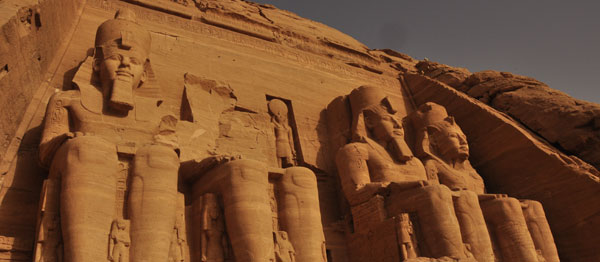
The towering pharaonic guards of the Abel Simbil temple in Ashwan, are truly mesmerising. Built into the rockface by the great Pharaoh Ramses 2, it was moved completely to make way for the Ashwan high damn.
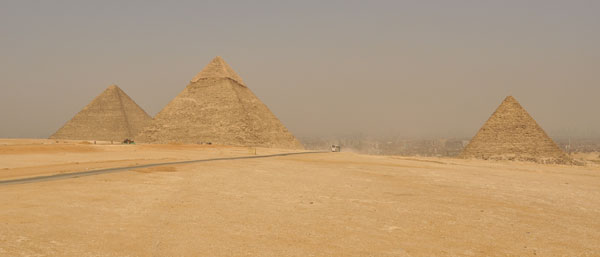
The great pyramids of Giza – the scale of these babies is quite astounding in real life (as are the number of tourists / touts)!